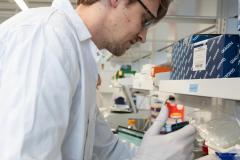New research published today (January 16) in The Lancet shows that twice as many people are dying of sepsis than previously estimated. The study determined that in 2017 there were 48.9 million cases of sepsis worldwide and 11 million died of the condition. This represents one in five deaths worldwide making sepsis a bigger killer than cancer or coronary disease.
Sepsis occurs when the body’s response to infection begins to damage its own tissues and organs. It can be life-threatening if not recognized and treated promptly and those who survive can be left with lifelong disability.
Sepsis can be a particular threat to young children as 40 per cent of sepsis cases worldwide occur in children under five years old.

Dr. Tex Kissoon is a co-author on the publication as well as Executive Medical Director of Global Health for Women and Children at BC Children’s Hospital, and professor at the University of British Columbia’s department of pediatrics. He has spent his career advocating for better sepsis management and researching how to improve sepsis treatment and prevention - especially in regions with limited health resources. He is hopeful that this new study will convince the United Nations and World Health Organization to commit to a coordinated global response and worldwide action.
“Eleven million deaths worldwide is a tragedy, especially as most cases of sepsis are either preventable or treatable if caught in time,” said Dr. Kissoon.
“We urgently need a coordinated global effort to tackle this crisis. Raising awareness of sepsis among both patients and medical practitioners and ensuring everyone has access to public health measures to prevent and basic healthcare to treat sepsis can greatly reduce the burden and ravages of this condition.”
The researchers examined data from more than 100 million deaths from 195 countries between the years 1990 and 2017. Previous estimates had been based on adult hospital admissions from only seven high-income countries.
“The impact of sepsis on the low and middle income countries was largely a black hole,” said Dr. Kissoon. “For too long global sepsis numbers had simply been extrapolated from a handful of high income countries. It took years of work to obtain more complete data in nearly every country in the world to get a much more robust picture of the global burden of sepsis. We found that it is a much bigger global threat than we thought.”
As well as presenting a larger global threat, sepsis is also a concern in Canada.
“Due to growing international travel, migration and climate change, people infected with tropical diseases or other common causes of sepsis are increasingly showing up in Canadian hospitals and we are ill prepared to recognize and treat these cases,” said Dr. Kissoon.
Amidst the alarming number of cases of sepsis globally there is some good news. The researchers found that in 1990 there were an estimated 60.2 million sepsis cases and 15.7 million deaths. By 2017, the incidence of sepsis had dropped by 19 per cent and deaths had dropped by 30 per cent.
“The biggest reasons for this decline are advances in vaccination, access to clean drinking water and better nutrition and housing due to the fact that nearly a billion people have been lifted out of poverty,” said Dr. Kissoon.
“But there is still much work to do to address the nearly 49 million people that are affected by sepsis. Current progress has been made in a haphazard way – imagine how many lives could be saved if there was a globally coordinated approach to tackling this problem.”
Dr. Kissoon is on the steering committee for the Action on Sepsis Research Cluster, based at BC Children’s Hospital and UBC, which aims to determine the best strategies and goals for preventing sepsis death. Action on Sepsis combines many different disciplines to tackle sepsis prevention, diagnosis and management and is a recognized leader in sepsis worldwide.
“Part of the reason why sepsis receives so little international attention despite the threat it poses to global health is because, unlike oncology or cardiology, there is no single medical discipline devoted to treating it,” says Dr. Kissoon. “This is why the work of Action on Sepsis and other sepsis advocacy groups are so important, because they are harnessing the research and expertise of clinicians, researchers, health care policy makers and the public to contribute to the fight against sepsis.”
Everyone can reduce their chances of developing sepsis by reducing the chances of infection. This includes thorough hand washing and getting the flu shot and pneumonia vaccines and taking antibiotics as prescribed.
For parents of young children who are ill with an infection, it’s important to ask their doctor if they have considered sepsis.
Further research and implementation of practices that lower the chance of hospital-acquired infections and reduce the prevalence of non-communicable diseases, such as diabetes, can also help prevent sepsis in the general population.
Learn more:
Global, regional, and national sepsis incidence and mortality, 1990–2017: analysis for the Global Burden of Disease Study
DOI: https://doi.org/10.1016/S0140-6736(19)32989-7
Additional authors on this research are:
Sarah Charlotte Johnson, Kareha M. Agesa, Katya Anne Shackelford, Derrick Tsoi, Danny V. Colombara, from the IHME; Daniel Rhodes Kievlan, Christopher W. Seymour, Derek C. Angus, from the University of Pittsburgh; Simon Finfer of the University of New South Wales; Carolin Fleischmann-Struzek, of Friedrich Schiller University Jena in Germany; Kevin S. Ikuta, Simon I. Hay, Rafael Lozano and Christopher J.L. of the IHME and University of Washington; Flavia R. Machado, of the Federal University of São Paulo; Konrad K. Reinhart, of Friedrich Schiller University Jena and Charité University Medical Center Berlin, both in Germany; Kathryn Rowan of the Intensive Care National Audit & Research Centre and the London School of Hygiene & Tropical Medicine, both in the U.K.; R. Scott Watson of the University of Washington and Seattle Children’s Hospital; T. Eoin West of the University of Washington; Fatima Marinho of the University of São Paulo; and Alan D. Lopez of the IHME and the University of Melbourne in Australia.
This research was funded by The Bill & Melinda Gates Foundation, the National Institutes of Health (grants T32HL007287, T32HL007820, R35GM119519), the University of Pittsburgh, BC Children’s Hospital Foundation, the Wellcome Trust and the Fleming Fund.




